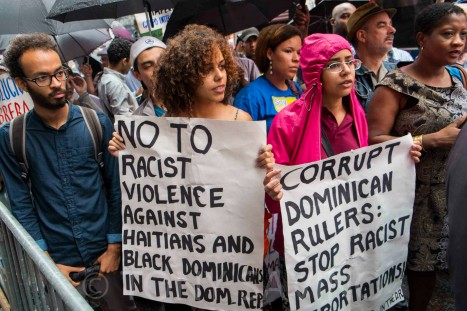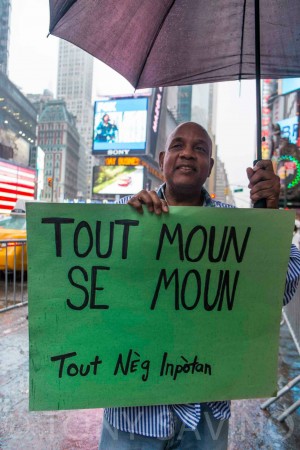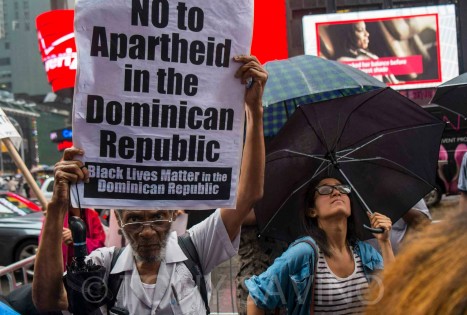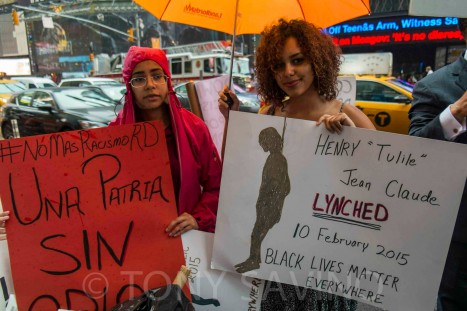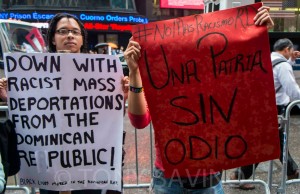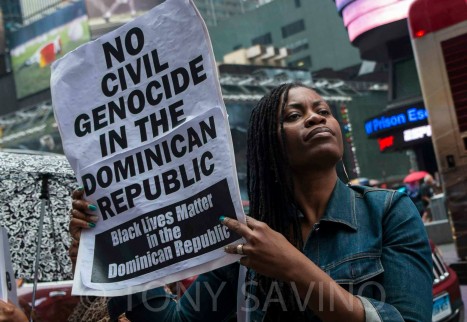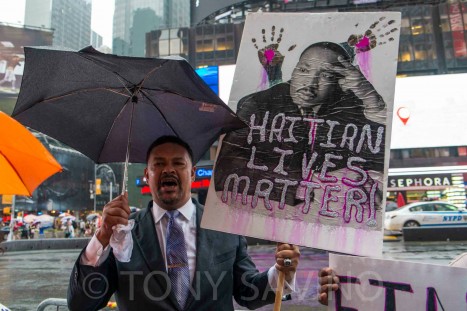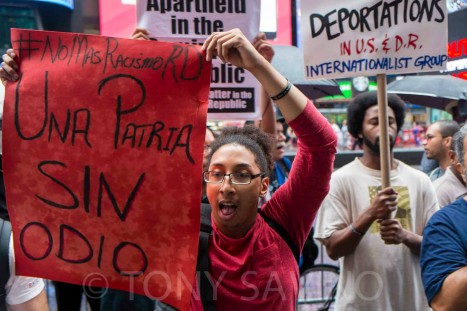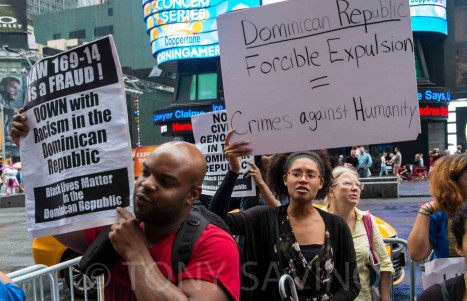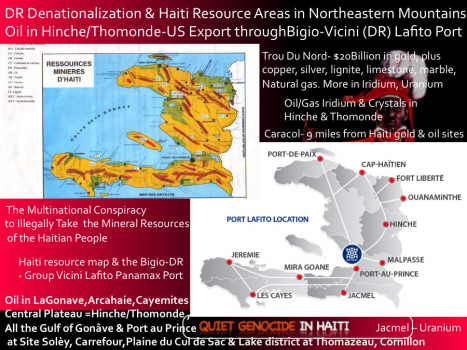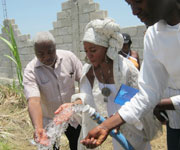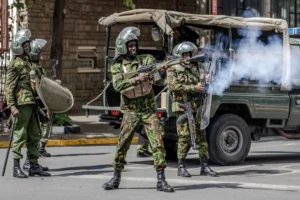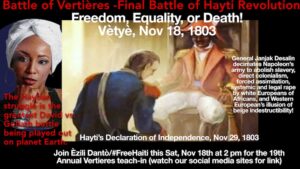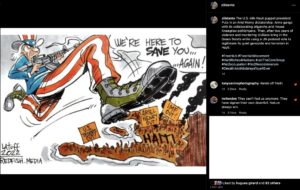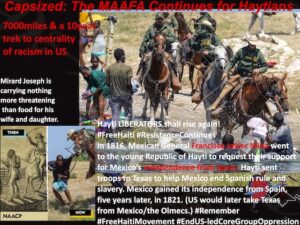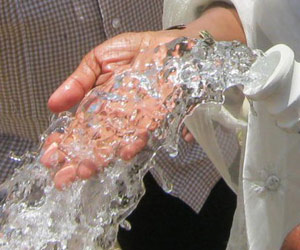1. Intro to this post – Corrupt Dominican Rulers, Stop Mass Deportations: No to Apartheid and civil genocide.
2. In this video we see Haiti women merchants fleeing the Dominican Republic.
3. Ezili Dantò interviewed on HuffPost Live segment with Marc Lamont Hill on Dominican denationalization, June 16, 2015.
4. Mark Steiner Show interview with Attorney Ezili Dantò”, Dr. Ray Winbush”, et al. Haitian Migrant Workers In DR Facing Deportation
5. The Real News Network with Jessica Desvarieux Interviews Haiti Human Rights Lawyer, Ezili Dantò of HLLN.
6. How big business fuels Haitian-Dominican Tensions
7. Global African interview Video
8. We Are All Dominicans Dominicans protest at the Dominican consulate in New York City to say no to deportations.
9. Dantò video: InterviewIt’s a myth: Haiti never invaded Dominican Republic. Haiti freed the entire island of Ayiti from slavery; help liberate five Latin American nations; help inspire countless resistance to slavery. July 2, 2015 protest Haiti gov. failures in DR denationalization
Gaye Prese Prese! – Protest in NY- July 2, 2015 from 3 to 6pm. Contact: Dahoud Andre at 347 730 3620 / Gade Martelly k ap chante “Ki te mele Bounda m” nan Manhattan pandan Sen Domeng ap choute Ayisyen tankou chen! Aba Mateli! Aba Lokipasyon! Viv Ayiti Granmoun nan Tout Kò l!
Corrupt Dominican Rulers: Stop Mass Deportations
“The white settlers and former slavers constantly want to wipe away from human history Haiti’s victory at the Battle of Vertieres.” —Haiti Resist US Occupation & Martelly-Lamothe Puppet Gov
White fear of genetic annihilation is real in the Dominican Republic. Like Brazil, Argentina, Jamaica and Cuba, these Caribbean and Latin American countries have a history of importing people of European ancestry to whiten their populations. This explains why Haiti is stigmatized throughout the world for her Black “taint.” It explain the current US occupation of Haiti, its unequal immigration policy – Cubans are allowed some immigration rights to the US, Haitians are mostly deported. The stigma of Blackness explains why there’s little world outrage about the UN rapes forcibly miscegenating the population, the imported cholera, fake aid, fake charity, mock elections under military occupation and the quiet genocide in Haiti. Whether a country creates state policies and acts for miscegenation or segregation, they’re just a different means to the same global economic, cultural and political ends.
The nations that opted for segregation, like the United States and the Dominican Republic, also imported more Europeans while slaughtering and oppressing the Black population. The US, like South Africa, has repealed its Jim Crow and apartheid laws. Dominicans, on the other hand, are going backwards to give their state practices legal force. Dominican law made apartheid legal with a 2013 law in order to accomplish the impossible, as the island of Ayiti was the first Black Republic in the Western Hemisphere and the Eurocentric partition of one side in 1844 to create a facsimile of the “little Spain” that existed before the Haiti Revolution, otherwise known as the Dominican Republic, does not erase the African bloodline and accomplishment that first brought liberty into application; first abolished slavery, forced assimilation and European colonialism.
Neocolonialism returned to Haiti in 1806 with the assassination of Haiti’s founding father by the mixed-race Mulatto sons of France, that Petion and Boyer diaspora – which had landed in Haiti with Napoleon’s French General Lerclerc to return Haiti back to slavery. On the East side of Ayiti, Spain managed to return in the form of Dominican Republic’s endemic violence and persecution of the Haitians, with the silent and oftentimes active complicity of most of the surrounding Eurocentric colonies and nations of the Western Hemisphere.
Below in four interviews, a video showing Haiti women merchants fleeing the DR, an Ezili Dantò video, you’ll learn that Haiti never invaded the Dominican Republic as has been taught to the Dominican people in the last 70-years by the corrupt, US-supported, Rafael Trujillo and JoaquÃn Balaguer rules (1930 to 1996), in order to generate more racial animosity against Black Haitians. The Dominican Republic is a clientelle US state and wouldn’t have denationalize Haitians without the silent complicity of the world’s most powerful nation. Haiti destabilization helps keep the UN and US occupation in Haiti. The Dominican Republic routinely deports people of Haitian descent to Haiti, especially during election times, to create more chaos. The DR has announced that scheduled mass deportation mau take place in 45-days. That’s around August 2015, which coincides with the time for the scheduled mock presidential (s)elections in Haiti. Also below, there’s a video from the We Are All Dominicans protest in New York against the Dominican Republic for its racism and its laws to carry out mass deportations, even against Dominicans of Haitians descent with DR citizenship rights and Haitians who are legal resident if they’ve not registered in accordance with the new apartheid identity rules.
The four interviews are from the Mark Steiner show, HuffPost Live, Real News Network and Global African (To be added). In these interviews, Ezili Dantò, president of the Haitian Lawyers Leadership Network and founder of the Free Haiti Movement speaks about how the Dominican Republic’s denationalization law is being passed off as a neutral “immigration regulation” instead of a morally offensive whitening law that’s morally offensive. At the Real News Network interview with Jessica Desvarieux, attorney Ezili Dantò explains how Haitian and Dominican oligarchs exploit Haitian laborers and fuel apartheid and ethnic cleansing policies. See also the article that corresponds with the Real News interview below entitled at “How big business fuels Haitian-Dominican Tensions.”
For those not familiar with the birthright struggle in the DR, where DR authorities are targeting “dark-skinned Dominicans with Haitian facial features” to deport to Haiti, see the HLLN Statement on the 2013 Dominican Republic apartheid law and racial profiling that made hundreds of thousands of Dominicans of Haitian descent stateless, and our Boycott the Dominican Republic announcements. For a deeper look at the realities of racism/white supremacy and imperialism in the DR and the déjà vu essence of this newly formalized DR ethnic cleansing, we invite you to watch: Sonia Pierre and the Struggle for Citizenship in the Dominican Republic; and Ezili Dantò interview on hidden US occupation, DR apartheid and Haiti resistance, or to read: 10,000 Haitians protest DR mistreatment and lynching, and A Barbaric Lynching in the Dominican Republic. (Check back here often and at the Free Haiti Movement, Twitter and Facebook, for updates.)
BRIEF ENGLISH SUMMARY: June 17, 2015 marked the deadline to register for legal residency. Some Haitians who fear deportation are avoiding going to the Dominican markets. This video show three women merchants rushing to return to Haiti now that there’s no semblance of legal protection for immigrants and the Dominican authorities are free to deport.
In the video we see women merchants fleeing the DR. The three women in the truck sold goods at their businesses in the Dominican Republic. They’re amongst the Haitians who tried to prove their legal residency and work status before the June 17, 2015 deadline. But, the women are saying here that they went to the registration center more than ten times, got a lawyer, brought in their birth certificates, work papers, house papers for where they live, bank account info, working permits, et al. But the Dominican Republic registering reps, said they needed 17 more pieces of paper and tore up their papers right in front of them after they had made more than 10 trips to the far away registration office that cost them more than a days wages in travel cost to get to; after they had paid a lawyer to draw up some of the papers requested; after they tried to fulfill all the legal residency requirements including hire the attorney the office said they should. The women are telling the interviewer, that they used all their monies on this endeavor. They say all the Haitians in the neighborhood where they were, left. They were the last ones. So they left too. They feared that if they stayed the Dominicans would steal all their belongings in “immigration raids.” They packed their belongings and headed back to Haiti for fear the collaborators with the registrar office and Dominicans that have their information, will come, take everything they own AND deport them… They said because they’re Haitian, the Dominicans would buy from them on credit and not pay them but threaten to call immigration on them…Before they left, one woman said that they tried to get paid from Dominicans who owed them, but the Dominicans said since they were leaving, why should they pay them at all. It’s not as if the Haitian women can go to the DR police to help them collect what’s due before they leave. For the past few weeks, hundreds of buses have been leaving Santo Domingo for the Haitian border.
Hundreds of thousands of Dominicans face deportation to Haiti
Hundreds of thousands of Dominicans face deportation to Haiti. Dominicans of Haitian descent have been swept up in a new whitening law that purports to address illegal immigrants. They’re rendered stateless due to the racist and draconian law which is locating, as far back as 1929, all birth certificates with Haitian surnames to demand that the people register to re-acquire citizenship or legal residency status. The deadline for citizens to register was February 1, 2015 and only 5,345 out of a possible 110,000 people the DR say are entitled to Dominican citizenship, registered.
The deadline for immigrants residing or working in the DR legal or illegal immigrants to register in order to avoid deportation was June 17, 2015. The Dominican Republic government says that out of a possible 500,000 in this category of non-citizens only 10,000 registered successfully, 250,000 applied, 300 were approved. Those in both categories who can be racially profiled as Haitians or Haitian descendants, whether they’re Dominicans of Haitian descent, Haiti workers with legal residency or illegal Haiti immigrants are all subject to deportation back to Haiti. Their identification papers, passports, old Dominican birth certificates are voided. Just a tiny percentage of those eligible to register under the law (February 1 and June 17th -Law 169-14 deadlines) were able to start the process before time ran out.
Dominicans of undocumented parents who did not meet the February 1st deadline are stateless and subject to deportation. Legal residents of Haitian descent and illegal residents who could prove they were in the DR before October 2011 but did not register at the June 17 rounds, are subject to deportation. Ezili Dantò from the Haitian Lawyers Leadership Network “HLLN” is interviewed on HuffPost Live segment with Marc Lamont Hill on Dominican denationalization, aired June 16, 2015.
***
Haitian Migrant Workers In The Dominican Republic Facing Deportation
Audio Player June 17, 2015 – Segment 4
June 17, 2015 – Segment 4
Mark Steiner Show interview with Attorney Ezili Dantò”, Dr. Ray Winbush”, et al..,
In the Dominican Republic, hundreds of thousands of Dominicans of Haitian descent, Haitians with legal residence and Haiti migrant workers, 90% of whom are Haitian, are facing deportation.
With: Attorney Ezili Dantò, President of the Haitian Lawyers Leadership Network in New York; Dr. Ray Winbush, Director of the Institute for Urban Research at Morgan State University;Silvio A Torres-Saillant,Professor of English at Syracuse University, former head of the Latino-Latin American Studies Program in the College of Arts and Sciences at Syracuse, and Founder of La Casita Cultural Center and the CUNY Dominican Studies Institute; andDr. Kiran Jayaram, faculty member in the Department of History and Philosophy at the York College of the City University of New York.
***
The Real News Network with Jessica Desvarieux Interviews Haiti Human Rights Lawyer, Ezili Dantò of HLLN.
Who benefits from depopulating both Haiti and Dominican Republic? Click here for the Video.
“The oligarchy in Haiti works with the oligarchy in the Dominican Republic. In Haiti that oligarchy is made up of a lot of billionaires, folks like Bigio and Acra and Mev. In Haiti we call them the mercenary families. They are the subcontractors for empire. In the Dominican Republic they also have an oligarchy. That oligarchy also … benefits from this denationalization.” -Ezili Dantò, HLLN/FreeHaitiMovement, Real News Network video and transcript.
***
|
“Haitian manual labor is so important in this sector that Dominican peasant leaders have admitted that the country’s growth is in large part due to the contributions of Haitian immigrants to the agricultural sector or to the growth of exports.”–90% of the agricultural workers in the Dominican Republic are Haitian, according to a report from the IDB and the World Bank “Haitians also are the most significant immigrant population in the Caribbean, adding substantial value to the economies of the Caribbean countries they reside in.” —The Western vs the Real Narrative on Haiti —Ezili Dantò, HLLN, March 21, 2007 Haiti’s Independence Debt, continues to be paid, endlessly.”–HLLN Archives “There is a clear preference among Dominican construction contractors for hiring Haitian workers, presumably because their precarious legal status makes them more flexible and willing to accept exploitative conditions and less likely to know their rights and be able to claim them.”–Haiti Construction Workers in the Dominican Republic: An Exploratory Study on Indicators of Forced Labor |
***
How big business fuels Haitian-Dominican Tensions
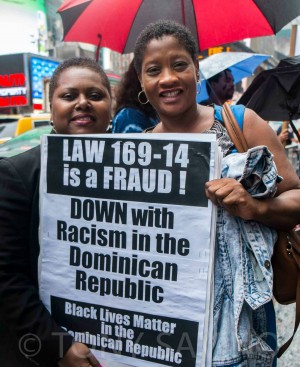
Boycott Dominican tourism, trade, products, industry for civil genocide and making apartheid legal. The Dominican ethnic cleansing policies violate human senses, not just their own Constitution and International law of good faith, equity and estoppel. Photo credit: Tony Savino
Who benefits most from the denationalization crisis created in the Dominican Republic? The corrupt Haiti and DR oligarchs work for the same Western/corporatocracy masters. The mining companies prefer to use created crises to take lands for their gold, old, iridium exploitations. Corrupt Dominican rulers are scapegoating people of Haitian descent in their territories to deflect from their own corruption and matters like the controversial Loma Miranda mining project. Residents living around the Loma Miranda ferronickel mine in the central province of La Vega require access to the mountain’s fresh waters, but the mining companies want the mountain and are determine to expropriate it for excavating gold. It’s the same situation in Haiti with Morne Bossa, where the foreigners are stealing, siphoning away, carting out Haiti wealth behind UN mercenary guns, while the people are made even poorer with other US policies, like US subsidies to big-agro that destroys Haiti food sovereignty.
In other areas, gold mining in the Dominican Republic has made sick thousands of people, especially the poorest peoples in the DR, many of whom are now in danger of simply getting expelled to Haiti, whether or not they’re Haitian. Referring to Loma Miranda, the mountain in central Dominican Republic that activists say is threatened by mining, Tony Sánchez, said:
““This is no longer a local fight, but a fight for the life of this country as a whole.”
The mining barons may simply unencumbered themselves of the people on these rich lands in the Dominican Republic, by deeming them illegal immigrants, especially if they’re darker-skinned Dominicans. The 2013 Dominican Republic apartheid law makes it possible for legal Haiti workers in the Dominican Republic, illegal Haiti migrants, as well as Dominicans of clear Haitian descent, who are all put in the same “regularization” net, to be deported, rounded up, imprisoned or warehoused in “processing centers” for deportation.
US colonial policies in Haiti and in the DR fuel and embolden the violence and legal persecution faced by people of Haitian descent who live in the Dominican Republic. The US-sponsored regime changes in Haiti, the current outsourced UN shoot-to-kill military occupation, NGO fake aid and their undemocratic, foreign-funded mock elections which deliberately brought to power a neoDuvalierist dictator, who doesn’t have to answer to a parliament, all, are examples of the forces imposed on Haiti to keep Haitians contained-in-poverty and as a ready pool of cheap labor, that’s politically helpless to protect itself from the civil genocide of the 2013 DR court ruling denationalizing Haitians back to 1929.
Bill Clinton apologized for his agricultural/unfair trade policies that assisted Arkansas rice growers in the US, but that destroyed Haiti food sovereignty. But Bill Clinton’s apology, like his “building-Haiti-back better”-chorus after the earthquake, is hollow and as fake and dishonest as Secretary of State, Hillary Clinton’s gifting Monsanto hybrid seeds to Haiti farmers as earthquake relief! These colonial policies, along with the media’s colonial narrative undermining Haiti image, falsely identifying it as the most corrupt, resourceless, without an awesome culture, and the most violent when that is not true; along with the constant political destabilization with US-sponsored coup d”etats and UN occupation, that are imposed on Haiti, help force Haitians to migrate elsewhere to find a better life. (See also, Haiti: Foreign Investment means Death and Repression: A Historical Perspective.)
Haiti’s ruling Oligarchy – Category Zero, The Mercenary Haiti families are the richest in the Caribbean, export all their income out of Haiti, don’t pay taxes, keep the people contained-in-poverty, instability and coup d’etat, the better to plunder and pillage Haiti.
The US government’s imperialistic pillage and plunder of poorer nations resources is the economic reasons for the numbers of Haitians forced to go find work in the Dominican Republic. These immigration and ethnic cleansing issues would not exist if both the Dominican Republic and Haiti were allowed by Empire – United States policies – to use the assets of their countries to elevate their own people’s domestic interests as oppose to foreign corporate interests. But debt, dependence and domination contains the entire global south in financial chains, compelling economic refugees to take dangerous journeys like going to the Dominican Republic or taking to the high seas to get to the richer U.S. (See, Gold Rush in Haiti: Mining Investment Good for Whom?)
If US companies like Timberland, the sugar industry, textile/garment industry, tourist industry and Major League Baseball would pay the same wages to Haitian and Dominican workers on the island of Ayiti as they pay to US workers and athletes in the United States, most of the peoples from this island, would have little reasons to immigrate as economic refugees.
Before the US occupation of the DR from 1916 to 1924 and Haiti from 1915 to 1934 and the UN Marines’ presiding over exporting Haiti workers to the DR, there was less racial animosity amongst the two sides. In fact, for those who don’t know, DR workers use to go find work in Haiti. Before the racist US occupation favored the lighter-skinned DR people and brought in more virulent Southern US racism, carted out Haiti gold and practically put Haitians back into slavery with the batéy in DR and the corvee in Haiti, Haiti was the RICHER nation on the island then. At the end of the day, instability, chaos and depopulating both sides of the island, profits the big US-Euro mining, gold, oil resource pillage companies who require conflict and divisions the better to exploit both the Dominican Republic and Haiti peoples. (See, 10,000 Haitians protest DR mistreatment and lynching.)
Take our word on this, Haitians would not wish the terror of the UN rapists and germ carriers on the DR, nor the NGO crisis caravan/poverty pimps. But already, the repugnant crisis caravan is landing in Haiti again with another reason to raise funds to “help” the denationalized Haitians as they “helped” the quake victims.
Big business’s complete silence on the racist policies in the DR is very telling. In fact, their own racist support for underpaid workers, their disparate treatment of Dominicans and Haitian workers and the apartheid they are part of, must be closely examined. In terms of other big business discriminatory worker policies that contain the Dominican Republic masses in poverty, we haven’t even gotten to Timberland, Major League Baseball, the remaining garment industry in the DR, and their economic stakes.
It’s exploited Haitian labor that’s helped to build the baseball academies and other construction projects, that all 30 Major League teams run in the Dominican Republic. These baseball plantations provide Dominican boys with coaching, baseball fundamentals, uniforms, education, dormitories and food. The academies serve as boot camps for potential Major Leaguers.
Timberland boots got its swagger because Black men and Hip Hop stars wear them in the United States. They too, have an economic stake in the DR that’s connected to Black life and wealth in the US. Yet, the Haiti laborers in the DR, who work at these businesses, as well as in the sugar cane and communication industries, are targets of a state act of terrorism that denationalizes and subjects at least 500,000 Haiti workers to immigration raids and summary deportation for failure to have registered by the June 17 deadline. These big billion dollar industries along with the big mining companies, like Barrick Gold, benefit when underpaid Haiti workers, lose their lands, are cheated out of their wages. Is this why they’ve remained silent on the DR’s new whitening and apartheid law that, in effect, makes the already persecuted Haiti worker, more of a target?
What say you Black men, who wear Timberlands, made in the Dominican Republic with underpaid laborers, now being rounded up in an apartheid state for deportation?

Racist Laws Breed Mob Violence. Photo credit: Tony Savino
We’ve had a “Boycott DR” campaign going for 2 years now. Baseball fans and Timberland fans ought to step up and demand that these two giants enterprises with deep tentacles in the African American community, who are using DR and Haiti immigrant labor, take a position demanding a repeal of the 2013 DR law that makes apartheid legal in the Western Hemisphere and endeavor to stop their own unequal treatment of their employees based on skin color and national origin.
Major League Baseball is adding to the apartheid by the way they pay their Dominican players and their US players. The same with the various garment factories, the sugar industry still in the DR, other agri-business, the garment/textile assembly plants, the booming DR construction industry. Also, it’s to be noted that part of the reasons Haitian workers are terrorized lie in geopolitical policies of unfair trade and neoliberal economics. After the 1980s, most of the big garment production factories in Haiti and the DR, moved to Bangladesh and Asia, which explains the shrinkage of the DR economy and the surplus migrant Haiti workers that the Dominican Republic are so anxious to expel.
The UN/NGO crisis caravan’s trumpeted “do-gooding” distorts the reality of US imperialism, neoliberal economics and hides the big moneyed interests pulling the strings to whitening Haiti and the Dominican Republic.
WATCH: On Just Cause, Piedad Cordoba explores the legal abuses committed in the Dominican Republic against citizens of Haitian descent based on changes to the country’s laws and constitution
The NGO poverty pimps are an organized crime syndicate allowed to fundraise on Haiti regime change, famine, earthquake, cholera, and now denationalization. Haiti suffers on. What’s hidden by the white savior/avatar crew posturing as rescuers and cholera fundraising is that the United States is not an impartial party but the respondiat superior, for instance, in the Haiti cholera case. The UN is employed as proxy military army, the fig leaf covering up the US occupation of Haiti. Huge amounts of water is required for Newmont mining/Barrack Gold to mine the Haiti and DR mountains. The charitable industrial complex consistently distorts reality to help empire hide its Haiti genocide and resource pillage with a “humanitarian crisis” face. The United States funds the Dominican military, supports the anti-Haiti deportations in that it provides millions of dollars in development and humanitarian aid to the DR. The DR is Washington’s strongest ally in the Caribbean. US military goals are indistinguishable from that of the Dominican Republic military when unleashing death squads, led by Guy Phillipe/Louis Jodel Chamblain in 2004 to cross into Haiti from the DR to unseat a popularly elected government. DR helps the US contain Haiti in debt, dependency and poverty. Two ($2) billion dollars in Haiti imports come from the DR. This would stop if Haiti’s domestic economy was not constantly destroyed by the US white supremacist policies, their NGOs invasion and the more favorite status empire accords the Dominican Republic over Haiti in trade for centuries. The US-DR forces control the Haiti-DR border with the Israeli government, uhmm “eyeing clean energy at border.” See video, the Quisqueya Binational Economic Council. It’s not Haiti immigrants invading the DR, but DR oligarchs, like the Vicini family, et al are pushing westward into Haiti.
Most scholars acknowledge there are more than 250,000 Dominicans of Haitian descent in the Dominican Republic, that nearly 90% of the Dominican population have African blood. Yet the 250,000 number keeps cropping up in the DR-Haiti denationalization crisis and coincidentally there’s 250,000 people apparently in the way of the US/DR-Israeli border project? Isn’t time we question the connections? Will the border “processing centers” for refugees, the new settlements of deported peoples from the DR populating areas along the Haiti border and the poor 250,000 “charcoal burning” people in the way of a joint US/Dominican Republic-Israeli border project, all be conflated together as one “Haiti refugee problem” to be solved? Expropriating Haiti water by privatizing it as “cholera relief” and expelling poor people from rich lands wanted by the big mining and oil companies wishing to tap into Haiti and DR mountains, aquifer, rivers, deep water ports and waterways for their resource extractions, seem mighty significant.
***
Extreme Xenophobia in Dominican Republic – Interview on the Global African
– For video: Click here, and entire transcript, here.
***
|
“…coercion is being used to pressure Haitian laborers to work in substandard conditions and to carry out hazardous tasks without protection, which occasionally results in the loss of life. A key component of such situations is employers” deliberate abuse of migrant workers” vulnerability, due to their mostly irregular migration status, in order to impose more extreme working conditions than would otherwise be possible (as in their designating Haitians for the most dangerous tasks, and assigning an individual the work of several people). Finally, the Haitian workers interviewed are routinely subjected to threats, ranging from threat of dismissal to death threats to threats of deportation.” —Haiti Construction Workers in the Dominican Republic: An Exploratory Study on Indicators of Forced Labor, pg.9 |
***
We Are All Dominicans
In a powerful show of solidarity, on June 15th, 2015
(See transcript to this video below and Dominicans Protest Move to Revoke Haitians of Citizenship.)
Dominicans protested at the Dominican consulate in New York City to say no to deportations. Deportations in the Dominican Republic of people of Haitian descent (or perceived Haitian descent) regardless of where they were born are set to begin this week in the Dominican Republic.
***
Video: Ezili Dantò interview on hidden US occupation, DR apartheid and Haiti resistance
Interview on Uhuru Radio with Norman Otis Richmond, Dec.13, 2013
Ezili Dantò speaks about the US occupation of Haiti, 10-years later; Dominican Republic apartheid and helping to give a Haiti-led, Haiti-capacity building international voice to the Haiti resistance
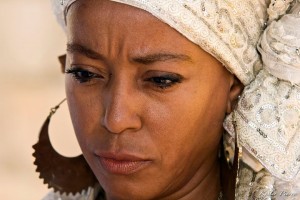
Ezili Dantò, Haitian Lawyers Leadership Network (HLLN) and Free Haiti Movement, June 18, 2015
“The West has two faces. One evil.”
People Power Movement: Haiti & Dominican Republic – Claudia de la Cruz
To help sustain this work become a paid monthly subscriber at $12 per month. Your support is much appreciated. Thank you.
Dominicans protested at the Dominican consulate in New York City to say no to deportations. Deportations in the Dominican Republic of people of Haitian descent (or perceived Haitian descent) regardless of where they were born are set to begin this week in the Dominican Republic. The community of Dominicans in the diaspora in New York, where the largest population of Dominicans outside of the mainland reside, planned this protest as part of a larger coalition to fight the deportations and anti-Haitian racism that plagues Dominicans and other Caribbean countries as a result of historical and systemic oppression. ”ª#”BastaYa”¬ ”ª#”BlackLivesMatter”¬ ”ª#”DominicanRepublic”¬ ”ª#”DominicanosPorHaiti”¬ ”ª#”WeAreAllDominican”¬ ”ª#”YoTambienSoyHaiti”¬ ”ª#”Ayiti”¬Transcript:
Chant:
¡Basta ya! ¡Basta ya!
¡Basta ya! ¡Basta ya!
¡Basta ya! ¡Basta ya!
Person one: Right now, precisely, we’re actually in front of the Dominican Consulate. I”m here, standing in solidarity with Dominicans of Haitian descent who are set to be deported in the hundreds of thousands. There is a government in the world that’s denationalizing a people and there isn”t a single international body that’s doing something about it.
Person two: It is a response by the Dominican government supposedly to regulate the immigration status of people in the Dominican Republic but what we understand is that in this process there are many Dominicans of Haitian descent who have been born in the country who are Dominicans who should be recognized as Dominicans that are also being potentially deported with this law as well.
Chant:
“Stop the racist terror! Stop the racist terror!
Stop the deportations!”
Person three: “So far I’ve seen a lot of support from Haitians, Dominicans , Americans and Americans of other Caribbean descent. I”m half Haitian and my father’s actually a leader of the Black Lives Matter in the Dominican Republic movement and I feel like it’s my duty to be here to help support worker in trouble who are being deported and oppressed.”
Person four: “Creo que hay muchos de nosotros que no entienden la historia capitalista e imperialista de nuestra isla.”
Person five: “A veces la lógica del estado dominicano y de la elite dominicana, más allá de los beneficios inmediatos que sacan a partir de la explotación del trabajador y trabajadora no tiene sentido a partir de ahÃ, de esa premisa.”Chant:
“Haitians Dominicans Black and White! Workers of the World Unite!”
Person three: “The more protests we have like this all around the world, and the more people we get involved and the more people we educate about this, the better it is for the Haitian people and Haitian-Dominicans.”Person six: “I feel that to actually make change we have to lobby and do things other than protest to find ways to reach those people who try to ignore us, like the people walking away from here. I feel like this is a good way to start, but I think the next step would be a way to actually engage the masses.”
Chant:
“…De Los Trabajadores!”
Person two: “Dominicans born either here in the United States or who have migrated here to the United States, we should be aware of how this resonates with our own community. We should understand that they are as Dominicans as anyone who’s living in the United States and claims a Dominican nationality.”
Person four: “Our cultures are different but similar in so many ways. We are- we are brothers and sisters in one island- both colonized people and we have liberated ourselves from that but a lot of people haven”t done that mentally. And we need to build that solidarity together in like places where joy is spread, where there’s music, where there’s dance. You know, we gotta do that.”– https://youtu.be/2F_l7_YsXqk
****
Sonia Pierre and the Struggle for Citizenship in the Dominican Republic
|
“Construction work is the second most important labor sector for Haitian migrant men in the Dominican Republic, following agriculture. Though it is relatively better paid than agricultural work, and therefore a more desirable option for many young Haitian men, construction work is also known for having dangerous and exploitative conditions, including pay far below minimum wage, longer working hours, and no days off.” —Haiti Construction Workers in the Dominican Republic: An Exploratory Study on Indicators of Forced Labor.” “The clearest and most egregious indicators of forced labor appear to be present in the Bávaro/Punta Cana region, where labor unions say there is a “different work culture” and few government or non-governmental agencies are willing to take on powerful investors and businessmen. To date, this study is the first to examine the working conditions of Haitian construction workers in the Bávaro/Punta Cana area. There are reports of other practices that warrant follow – up and intervention, such as workers being shot at when attempting to collect pay and employers “disappearing” the bodies of workers who have died on the job from electrocution or a fall from scaffolding. Further investigation is necessary in order to corroborate the data collected and begin to ameliorate the culture of impunity present in this area of high foreign investment and little State presence.” —Haiti Construction Workers in the Dominican Republic: An Exploratory Study on Indicators of Forced Labor.” “the study detected several practices that may or may not constitute forced labor indicators, but are certainly exploitative. These include employers” withholding for health and accident insurance but providing no coverage, and employers” “calling Migration” or organizing false migration raids to avoid paying workers, as well as police abuse and complicity between employers and authorities in covering up accidents and abuse of workers. .” —Haiti Construction Workers in the Dominican Republic: An Exploratory Study on Indicators of Forced Labor.” pg. 10 “The labor movement continues to call for the Dominican government to comply with international human rights norms, and ensure Dominicans of foreign descent are given the ability to fully and freely participate in society. The United States government and the international community, including the United Nations and International Labour Organization (ILO), must use all means available to pressure the Dominican government to stop its discriminatory persecution of the Haitian community to quell a growing humanitarian crisis. Countries that flagrantly disregard human rights do not deserve financial and military assistance or preferential treatment through trade agreements like DR-CAFTA. “—-AFL-CIO: ‘Ethnic Cleansing’ in the Western Hemisphere: The Impending Deportation Crisis in the Dominican Republic, June 18, 2015 *** Dominican Republic Plan for Migrants Rife with Irregularities ***
1199 Press Release – June 19, 2015 “As the largest healthcare workers union in the United States, we represent thousands of caregivers and their families who are of Dominican and Haitian descent. The threat of the government of the Dominican Republic to deport hundreds of thousands of Dominicans of Haitian descent is deplorable. In light of the recent adoption of laws that essentially strip the citizenship of 200,000 people of Haitian descent born in the Dominican Republic, the deportations can only be seen as an attempt at ethnic purging. “Many Dominicans of Haitian descent have spent decades of their lives in the country or may be second or third generation residents. They should have the basic human right to remain in the country in which they have made their homes. Just as we have always denounced racist and anti-immigrant practices in the United States, we denounce these inhumane deportations. Instead, we affirm the basic rights of Dominicans of Haitian descent and call for compassion, unity, tolerance, and human solidarity. “We call on elected officials in the United States to demand the halt of deportations. And we urge people of conscience everywhere to contact the White House, the State Department, and the Dominican government to speak out against the discrimination of people of Haitian descent in the Dominican Republic.” –George Gresham, President of 1199SEIU United Healthcare Workers East. ### With over 400,000 members throughout the East Coast, 1199SEIU United Healthcare Workers East is the largest and fastest-growing healthcare union the nation. Our mission is to achieve quality care and good jobs for all. |
Add a comment:
Powered by Facebook Comments

